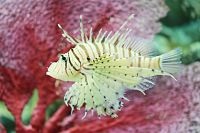The Lionfish Not a Native to The Gulf of Mexico
The Lionfish originate from the Indo-Pacific and Red Sea. Lionfish began appearing in the Gulf of Mexico in 2010, and they have now made our Gulf of Mexico home and are rapidly spreading throughout the region. The presence of the Lionfish has substantially affected New Orleans charter fishing. It is believed that the Lionfish spread into the Gulf after they were introduced by people who had them in aquariums near the area of Southeast Florida in the 1980’s. Louisiana fishing charter captains are watching and recording the migration and captures of this predator in the Gulf of Mexico. This fish could impact the numbers of native fish in our region.
Lionfish Facts
- It is not uncommon to find more than 100 lionfish on a small reef at one time
- Lionfish possess 13 dorsal, 2 pelvic, and 3 anal spines that are venomous
- An accidental stick from a Lionfish can be very painful
- They have fins that are needle-sharp, and can easily penetrate wet suits
- Lionfish are very elusive to the angler hook & line, making them difficult to catch
- Lionfish have no natural predators in our area, nothing in our Gulf of Mexico will eat them except us!
- Lionfish eat aggressively our native fish and crustaceans
- The Lionfish has been observed eating prey up to 2/3 their own size!
- Lionfish have shown the ability to withstand starvation for periods of up to 12 weeks.
- Lionfish are found in higher densities in our Gulf of Mexico compared to other invaded regions
- Lionfish in the Gulf of Mexico are capable of releasing up to an average of 27,000, but as high as 115,000 eggs as often as every 2-3 days.
- Lionfish are typically white, with maroon stripes, but they have the ability to change colors to blend in with their environments over time.
- You may also find Lionfish that are almost completely white or black.
Size Matters
 Adult lionfish in the Gulf of Mexico can average approximately 9 inches long, and just over one-half pound in weight. Remember from the above list, they can eat prey up to 2/3 their own size. The largest lionfish recorded in the Gulf of Mexico was 17.2 inches long. The world record lionfish was captured in Southeast Florida and was 18.5 inches long. These numbers can certainly grow, as the amount of Lionfish are captured and recorded.
Adult lionfish in the Gulf of Mexico can average approximately 9 inches long, and just over one-half pound in weight. Remember from the above list, they can eat prey up to 2/3 their own size. The largest lionfish recorded in the Gulf of Mexico was 17.2 inches long. The world record lionfish was captured in Southeast Florida and was 18.5 inches long. These numbers can certainly grow, as the amount of Lionfish are captured and recorded.
What to Do if you Capture this Predator
Well, for starters, be careful. Handling this predator can lend to be quite painful if you are stuck by one of their many venomous fins. Though the sticks have not shown to cause fatalities, they can cause swelling and extreme pain. The Lionfish Coalition suggests using submersion in non-scalding hot water. Over-the-counter anti-inflammatory or pain medications may also be helpful in reducing the pain and swelling associated with a lionfish sting. Allergic reactions or shock symptoms should be considered an emergency situation, and you need to seek immediate medical treatment.
Now, if you happen to “safely” capture a few Lionfish, their a quite a tasty meal. Their meat is mild, sweet, and flaky. Lionfish can be prepared many ways and Lionfish are just as safe to eat as Snapper and Grouper. Use these tasty lil predators in chowder, sautéed, deep fried whole, even with lemon or lime in ceviche.
Recipes for Lionfish, Let’s Eat Them Before They Eat Our Native fish!
Fried Lionfish
Ingredients:
- 42 ounces Lionfish fillets, patted dry
- Flour (for coating)
- 5 cloves of diced garlic
- 2 cups chopped cherry tomatoes
- 1/2 cup white wine
- 1/4 cup fresh-squeezed lemon juice
- 2 T. chopped fresh basil
- lemon wedge for garnish
Preparation: Dredge fillets in flour to lightly dust. Place in sauté pan with small amount of hot butter over medium heat. Cook first side, careful not to burn.
Turn over fish when golden, and reduce heat. Add the garlic, tomatoes, white wine and lemon juice. Cover and cook until fish is fork-tender. Garnish with a lemon wedge.
Lionfish Ceviche
The acid from one or more types of citrus juices “cook” the fish, while flavors are added with chilies, and herbs. Ceviche should only be made with the freshest of seafood.
Ingredients:
- 1/4 cup fresh-squeezed lemon juice

- 1/3 cup fresh-squeezed orange juice
- 3 Tbs. fresh-squeezed lime juice
- Pinch of sugar to taste
- Pinch of salt to taste
- 1/2 lb. lionfish fillets cut into 1/2-inch cubes
- 12 cherry tomatoes, quartered
- 1 small, ripe avocado, pitted and cubed
- 1/2 cup cubed cucumber
- 2 serrano chilies, minced
- 2 Tbs. fresh cilantro, chopped
- 1 Tbs. fresh mint, chopped
- 2 Tbs. olive oil
Directions:
In a glass or plastic bowl, stir together lemon, lime, and orange juices. Season with salt and just enough sugar to offset the acid of the citrus juice.
Cut the Lionfish filets into 1/2-inch cubes, and add to the citrus juice. Be sure to Completely cover the fish with the citrus juices, this basically “cooks” the fish with the acids. Cover and refrigerate for 1 hour.
In a bowl, combine the tomatoes, avocado, cucumber, chilies, cilantro, and mint and stir to combine.
Transfer the fish to a colander and drain for several seconds. Once drained, add the fish to the tomato mixture and mix.
Drizzle with the combined ingredients with oil and salt to taste
Divide the ceviche among four small bowls and serve immediately.
If you are interested, click the lionfish records link for the current Gulf States lionfish records, and to report a state record in the Gulf of Mexico that you have captured, please contact the Gulf Coast Lionfish Coalition for instructions



